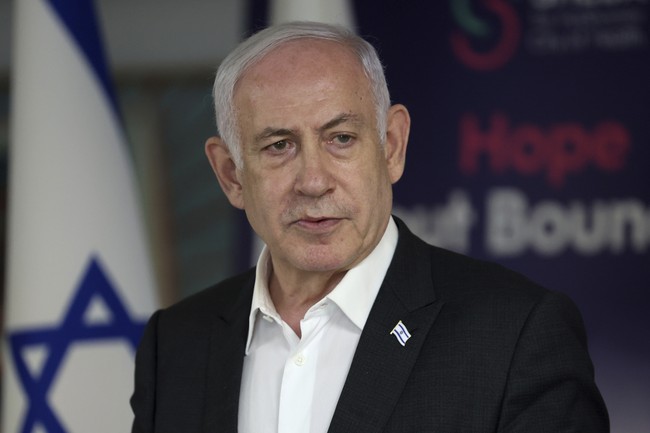We support our Publishers and Content Creators. You can view this story on their website by CLICKING HERE.

One suspects that Hezbollah has already figured this out. Has Iran? At the very least, residents of southern Lebanon grasp it now, and those in the Bekaa Valley may be learning it as this gets published.
Advertisement
In case anyone else hasn’t figured it out, Benjamin Netanyahu spelled out Israel’s new security strategy after October 7. They will pre-empt attacks rather than wait for their enemies to throw the first punch:
The IDF is pre-empting threats rather than waiting to respond to attacks, Prime Minister Benjamin Netanyahu said as he held security consultations as the IDF struck Hezbollah targets in Lebanon and called on civilians in Southern Lebanon to evacuate.
“For those who have not yet understood, I want to clarify Israel’s policy – we do not wait for a threat. We pre-empt it everywhere, in any arena, at any time.
“We are eliminating senior officials, terrorists, destroying missiles – and our hands are outstretched,” he said as he met with Defense Minister Yoav Gallant and IDF Chief-of-Staff Herzi Halevi.
“Whoever tries to harm us, we will harm them even more,” Netanyahu said.
Does this actually count as pre-emption? Hezbollah has bombarded northern Israel since October 8, in support of Hamas’ barbaric atrocities in launching a new phase of a 19-year war. This may be better understood as a policy that ends the doctrine of symmetrical response. Israel intends to end threats rather than allow them to fester, especially those that go beyond potentiality and become operational.
We are seeing that clearly in the last few days since Operation Grim Beeper. Just how much data did Israel glean from Hezbollah’s pagers in the months before they exploded? Residents in southern Lebanon may soon find out — if they haven’t already. As Hezbollah and Israel escalate the fighting that the former launched after Hamas’ massacre on October 7, the IDF seems to have a pretty good idea where Hezbollah stores its weapons.
Advertisement
Today alone, the IDF struck over 300 locations in southern Lebanon:
The IDF hit over 300 Hezbollah targets during two major rounds of strikes against Hezbollah on Monday. …
These waves of air strikes constituted the fifth and sixth round of massive air strikes on Hezbollah since Thursday of last week, especially in southern Lebanon, including further from the border than in some prior cases.
Among the attacks was a significant strike against Hezbollah deep into Lebanon’s Bekaa Valley. A senior Hezbollah official, Ali Aburia, was reportedly killed in one of the IAF strikes on Lebanon, Sky News Arabia reported on Monday, citing multiple sources.
Numerous reports of secondary explosions after these strikes suggest that the Israelis had a very good idea where to hit Hezbollah. So far, at least, Hezbollah hasn’t launched any missiles at Israel during or after these sorties:
More footage from Israel’s attack on Hezbollah targets across southern Lebanon. Hezbollah failed to launch a single barrage today so fat. It will, definitely, but its arsenal suffers heavy blows https://t.co/OVQd5N8luJ pic.twitter.com/YPOoBoGxII
— Guy Elster (@guyelster) September 23, 2024
Most of these attacks took place in southern Lebanon, where Hezbollah stores and operates its less-effective, shorter-range missiles. Their more effective weapons are believed to be staged in the Bekaa Valley, much farther north and more difficult to reach. That’s where the next sorties will go, Israel warned residents, telling them to evacuate if they live where or near those weapons are stored:
Advertisement
IDF Spokesman Daniel Hagari on Monday afternoon warned Lebanese civilians to evacuate Bekaa Valley areas where Hezbollah has hidden rockets, drones, and long range strategic weapons.
Hezbollah has many longer range strategic weapons in the Bekaa Valley because it is farther from the border with Israel, making collecting intelligence about the weapons and attacking them more difficult.
While the impact of Hagari’s warning may be to cause a mass evacuation from the area, the IDF did not say that the whole area must be evacuated, rather focusing on residences where weapons are hidden.
However, given that the IDF has accused Hezbollah of hiding weapons in every three to five houses in parts of Lebanon, the impact of Hagari’s threat could be a mass evacuation.
Hagari didn’t give them much time — only a couple of hours. By the time this post goes up, the Israeli air force may have already begun those sorties against suspected weapons caches in the Beqaa Valley.
How good is their intel? The pagers may loom large in this situation. Clearly the Israelis intended them as a highly targeted strike on Hezbollah leadership. Just from that success alone, Hezbollah would have a very difficult time relocating those weapons in any organized fashion for weeks, if not months. That means any intel that Israel had before the pager explosions will likely remain actionable for a long time. But suppose Israel had put tracking capabilities in those pagers and collected data on the movements of thousands of higher-ranking personnel. In that case, they may have a very accurate picture of what to hit with these sorties.
Advertisement
What about the lack of effective response from Hezbollah? Pagercide (or Operation Grim Beeper, if you prefer) probably explains much of it. Hassan Nasrallah passed them around to everyone who coordinated people or equipment in the Hezbollah network, which presumably would include those who worked in the command chain for missile launches. Even for those who didn’t get injured by Pagercide, their internal communications are heavily disrupted, which will take months to repair. Israel isn’t waiting around to find out, though — they’re going after the strategic systems before Hezbollah can reorganize to use them effectively.
That doesn’t mean that Hezbollah is entirely helpless. The IDF believes that their cyberwarfare resources may be ready to launch a response to Operation Grim Beeper:
So far, Hezbollah has responded with a massive rocket barrage on northern Israel over the weekend. However, the Iranian-backed group is also believed to have cyber capabilities that could be used in retaliation. …
“As the greatest drug barons in the world, Hezbollah and Iran have wide-reaching infrastructure, the ability to create shell companies and launder money all around the globe that enables them to transport whatever they want to wherever they want,” retired Cmdr. Dr. Eyal Pinko, a senior research fellow at the Begin-Sadat Center for Strategic Studies and a former senior consultant for intelligence, cyber, and security at the Israeli National Cyber Directorate, told The Media Line. “These abilities exceed those of Israel by far.”
This infrastructure gives Hezbollah the potential to conduct attacks similar to last week’s pager explosions.
Pinko explained that Hezbollah operates on the darknet, an encrypted and anonymized section of the internet, to trade in security vulnerabilities. The group uses its funds to buy these weaknesses, which allow them to carry out cyberattacks. Breach investigators, who identify these vulnerabilities, are in high demand, and Hezbollah’s resources allow it to hire skilled experts and acquire time-sensitive information.
Advertisement
Well, maybe. But if Hezbollah had that kind of attack ready, they probably would have launched it after October 7, when it might have allowed Hamas to keep attacking Israel. Going after drug dealers is somewhat different than attacking a state with its own expertise in this kind of warfare, an expertise to which the Iranians can certainly attest. Hezbollah will certainly try to go after Israel in cyberspace, especially since it might be the only part of their arsenal they still can access. But how many of their commanders in cyberspace carried pagers?
Addendum: Hezbollah has fired 165 rockets into Israel so far today, at least 10 of them long-range and aimed at West Bank settlements. It’s not clear whether those all came from southern Lebanon or whether some may have been launched from Bekaa.

 Conservative
Conservative  Search
Search Trending
Trending Current News
Current News 







